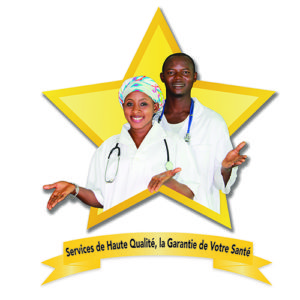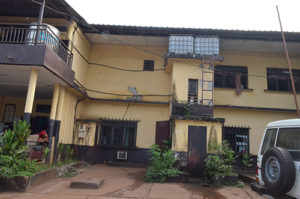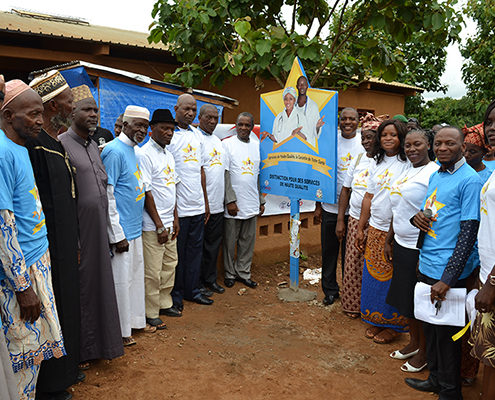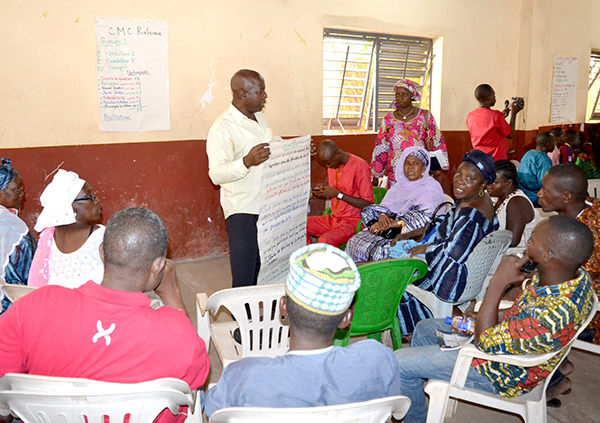As part of HC3’s Mano River Region effort, the HC3 project helped Ministry of Health partners to rebuild trust in the health services and increase use of health structures in Conakry, Basse Cote and Guinea Forestiere, the areas of the country hardest hit with Ebola. HC3’s activities had three objectives: promote the Gold Star services in Guinea – a collection of 15 service sites where the Maternal and Child Survival Program (MCSP) Project has improved services; engage communities and health facility staff to improve additional health service structures to encourage people to use health services again after the Ebola crisis; and finally build the capacity of the Ministry of Health (MOH) Health Promotion Unit (HPU) to conduct social and behavior change communication (SBCC) activities.
Demand Creation and Service Promotion at Gold Star Sites
 In collaboration with MCSP and the Ministry of Health, HC3 revamped a quality brand—entitled “Etoile d’Or,” or Gold Star— promoted nationally and regionally through a mass-media campaign that includes radio, television, billboards and community events. The campaign aims to build confidence in as well as increase the use of health services. Since 2012, MCSP has identified and assisted health facilities to meet quality criteria for service through a months-long accreditation process. Once accredited, a health facility receives a “gold star,” which is prominently displayed both inside and outside the facility. Currently, 15 facilities across the country have already received a gold star and another 22 are undergoing the accreditation process.
In collaboration with MCSP and the Ministry of Health, HC3 revamped a quality brand—entitled “Etoile d’Or,” or Gold Star— promoted nationally and regionally through a mass-media campaign that includes radio, television, billboards and community events. The campaign aims to build confidence in as well as increase the use of health services. Since 2012, MCSP has identified and assisted health facilities to meet quality criteria for service through a months-long accreditation process. Once accredited, a health facility receives a “gold star,” which is prominently displayed both inside and outside the facility. Currently, 15 facilities across the country have already received a gold star and another 22 are undergoing the accreditation process.
By promoting the brand nationally, HC3 inspired non-Gold Star facilities to strive to achieve the same high-quality standards that Guineans desire and deserve. The Gold Star Quality Services promotion will encourage people to return to the life-saving health-care services that they stopped using during the time of Ebola.
HC3 also worked with local NGOS to increase the demand for health services through community health outreach activities. Hundreds of community health workers were trained using the Bridges of Hope community toolkit to promote overall wellbeing and health habits at home.
Dialogue
 Facilitated community dialogues took place in health facilities with health providers, elected officials, religious leaders, community leaders and women’s groups. HC3 encouraged these discussions about the quality of services and perceptions of care. Community dialogues produced a list of desired changes to the services, and quality teams were identified to lead the process of improving the services. Dialogue was the first step of a quality improvement and promotion process that HC3 led to ensure that communities were activity involved in the quality improvement process. Once the list of desired changes were validated by community and health facility staff, Quality Teams recruit community volunteers, who work with a construction company to clean up and make-over the health facility. As part of the package of support to facilities, HC3 provided refresher training to improve providers’ interpersonal communication and counseling since provider attitudes are frequently listed on the list of challenges to be fixed.
Facilitated community dialogues took place in health facilities with health providers, elected officials, religious leaders, community leaders and women’s groups. HC3 encouraged these discussions about the quality of services and perceptions of care. Community dialogues produced a list of desired changes to the services, and quality teams were identified to lead the process of improving the services. Dialogue was the first step of a quality improvement and promotion process that HC3 led to ensure that communities were activity involved in the quality improvement process. Once the list of desired changes were validated by community and health facility staff, Quality Teams recruit community volunteers, who work with a construction company to clean up and make-over the health facility. As part of the package of support to facilities, HC3 provided refresher training to improve providers’ interpersonal communication and counseling since provider attitudes are frequently listed on the list of challenges to be fixed.
Collaboration
Rehabilitation work was conducted in a way that patients can continue to utilize the facility. Repairs were made to ceilings, lights and benches while painters gave rooms a clean fresh coat of paint and men and women from the community cleaned the grounds and the common areas of the facility. Together they assessed progress, and push on until the rehab was completed. Health facility staff and communities have been very pleased by the transformation of the sites.
Knowledge Management
HC3 worked with the Health Promotion Unit (HPU) at the MOH to improve how they produce, organize and disseminate SBCC tools and materials. Streamlining these processes enabled better communication and collaboration within the MOH as well as among local and international NGO partners working in the health sector in Guinea.




